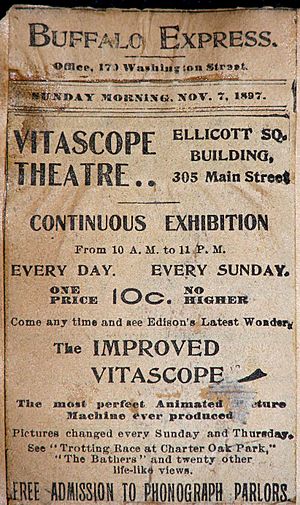Edisonia Hall facts for kids
Edisonia Hall was a common name for special places where people could see the amazing inventions from Thomas Alva Edison's company. These inventions included the phonograph, which played sounds, and early movie machines like the Vitascope and Kinetoscope.
The First Movie Theater
One very important Edisonia Hall opened in Buffalo, New York, on October 19, 1896. It was started by Mitchell Mark and Moe Mark inside the Ellicott Square Building. This particular Edisonia Hall was special because it had a dedicated Vitascope Theater. This means it was the very first building known to be built just for showing movies!
What Was the Vitascope Theater?
Newspapers back then called this theater by different names. Some called it the Vitascope Theater, others the Vitascope Hall, or even the Electrical Theater. No matter the name, it was a place where people gathered to watch moving pictures on a big screen.
Early Films and Popularity
Many of the first movies shown at this theater were from Lumiere Films. These were obtained through a company called Pathe Freres. The theater was very popular! In its first year, over 200,000 people came to see the films. This Edisonia Hall stayed open for almost two years. This was much longer than any other early movie theater known at the time. Its historical importance was confirmed in an article published by the Buffalo News on November 25, 2007.


